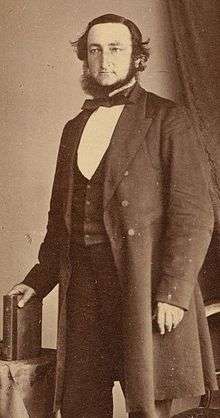Randolph Isham Stow

Randolph Isham Stow (17 December 1828 – 17 September 1878) was an English-born Australian Supreme Court of South Australia judge.[1]
Stow was born in Framlingham, Suffolk, England, the eldest son[2] of the Rev. Thomas Quinton Stow and his wife Elizabeth, née Eppes.[1] The family migrated to Adelaide, South Australia in 1837; Randolph and his brothers Jefferson and Augustine were educated at home by their father and at a school run by D. Wylie.[1] M.A.
Randolph Stow showed great ability as a boy[2] and was articled (apprenticed by contract) to a firm of lawyers, Messrs. Bartley and Bakewell.[3] Shortly after the completion of his articles Stow became a junior partner in the firm. In 1859 Stow started a business for himself.[1] Later, Stow was a partner with T. B. Bruce (1862–1872) and F. Ayers.[1]
Stow was a member of the South Australian House of Assembly as member for West Torrens 1861-2, for Victoria 1863-65, East Torrens 1866-68 and Light 1873-75.[1] In October 1861 Stow became Attorney General in the Waterhouse (ministry which held office until July 1863). Stow was Attorney General again in the Henry Ayers and Arthur Blyth ministries from July 1864 to March 1865 and then lost his seat.[2] He was now one of the leaders of the South Australian bar, and became a Queen's Counsel in this year. By 1875 Stow was the unchallenged leader of the bar at Adelaide, and on 15 March 1875 was appointed judge of the Supreme Court,[2] in place of William Alfred Wearing, who died on the wreck of the SS Gothenburg. Stow's health, however, had not been good for some time, and he had a heavy workload; he died age 49 of atrophy of the liver on 17 September 1878.[1] He left a widow, four sons and two daughters.[2] One of his sons, Percival Randolph Stow, later married K. Langloh Parker.[4]
As a member of parliament Stow was regarded as a first-rate debater and took a leading part as Attorney-General in putting through legislation of much value. As an advocate he possessed an accurate knowledge of law, but he made his greatest impression as a judge although he was on the bench for less than four years.[2] At the time of his death there was a general feeling that South Australia had lost a great judge, and many years later Sir John Downer who became a Q.C. in the year Stow died, said of him that he was
"one of the greatest judges Australia ever had. A commanding presence, a striking face, an exquisite voice, unusual swiftness in comprehension, with an immense combination of eloquence and power". (Quoted at the time of Downer's death in The South Australian Advertiser, 3 August 1915).
Family
Randolph Isham Stow (17 December 1828 – 17 September 1878) married Frances Mary MacDermott (c. 1836 – 25 December 1914), daughter of Marshall MacDermott on 7 November 1854. Their family included:
- Percival Randolph Stow (c. 1857 – 20 December 1937) married Catherine Somerville "Kate" Langloh-Parker ( – 27 March 1940), widow of Langloh-Parker.
- Ella Harriet Stow (15 October 1858 – 1 June 1944)
- Adelaide Elizabeth Stow OBE (31 May 1859 – 14 February 1945) married Lieutenant (later Vice-Admiral Sir) William Rooke Creswell (20 July 1852 – 20 April 1933) on 29 December 1888
- Reginald Marshall Stow (6 Sep 1862 – 26 April 1920) married Gertrude Mary Sullivan ( – ) on 28 April 1915
- Ernest Alfred Stow (18 January 1864 – 27 March 1885)
- Francis Leslie Stow LLD (16 Oct 1869 – 12 May 1935) married Annie Duxbury (1 April 1869 – ) on 6 May 1895. He was the first to graduate LLD. from the University of Adelaide, and the first to win the Stow Scholarship, Stow Prize, and Stow Medal all founded in honor of his father. He served as Crown Solicitor and Crown Prosecutor in Perth, Western Australia.
References
- 1 2 3 4 5 6 7 D. Bruce Ross, 'Stow, Randolph Isham (1828–1878)', Australian Dictionary of Biography, Volume 6, Melbourne University Press, 1976, pp 201-202. Retrieved 29 March 2010
- 1 2 3 4 5 6 Serle, Percival (1949). "Stow, Randolph Isham". Dictionary of Australian Biography. Sydney: Angus and Robertson.
- ↑ Mennell, Philip (1892). "
 Stow, His Honour Randolph Isham". The Dictionary of Australasian Biography. London: Hutchinson & Co. Wikisource
Stow, His Honour Randolph Isham". The Dictionary of Australasian Biography. London: Hutchinson & Co. Wikisource - ↑ "Family Notices.". Sydney Morning Herald. NSW: National Library of Australia. 15 December 1905. p. 6. Retrieved 24 September 2015.
- "General Summary". The South Australian Register. 18 September 1878.
- "Proceedings in Parliament". The South Australian Advertiser. 18 September 1878.
| Political offices | ||
|---|---|---|
| Preceded by Henry Strangways |
Attorney-General of South Australia 20 May 1861 – 8 Oct 1861 |
Succeeded by Henry Gawler |
| Preceded by Henry Gawler |
Attorney-General of South Australia 17 Oct 1861 – 4 Jul 1863 |
Succeeded by Richard Andrews |
| Preceded by Richard Andrews |
Attorney-General of South Australia 22 Jul 1864 – 22 Mar 1865 | |
| Preceded by Henry Ayers |
Premier of South Australia 3 November 1868 – 30 May 1870 |
Succeeded by John Hart |
|}